
What are the best ways to celebrate international women’s day?

What are the best ways to celebrate international women’s day? The best way to have a creative motivational women’s day in the workplace.
The world is marching towards a progressive, technologically advanced and socially diverse community. And the time has come to do everything possible for greater women’s involvement and participation both at the workplace and in everyday life.
As the International women’s day is around the corner, most people look out for creative women’s day programs in our workplaces. So, here are some useful ideas to mark your day in a creative, positive, and thoughtful manner.
We usually celebrate this day by attending cultural performances, sending roses to each other, or sending sweet text messages. All these things are some of the ways of remembering this day. But how about we plan something different this time and be a little unpredictable?
The theme for 2020 International Women’s Day is #EachForEqual. It focuses on how each one of us can be a participant in the march towards equality. So, what activities can organisation conduct to highlight this aspect while celebrating this year’s women’s day programs? Know it below.
Activities to celebrate Women’s Day

- Create an IWD 2020 pledge wall
Engage your workers and encourage them to commit an action to forge a more gender-equal world by creating a pledge wall. It is an activity that also works for organisations that have implemented team segregation as part of the business continuity planning. Just leave the wall as long as it takes for a full team rotation (e.g. for the month of March). Consider the tips given below to create your own pledge wall:
Step 1: Select a wall in the workspace.
Step 2: Set the context. Explain what #EachforEqual means and why a gender-equal world is essential.
Step 3: Give a call to action. You can use the questions like “What action can I take to help forge a more gender-equal world?”
Step 4: Get your employees to write their name on the cards. Then, write a specific and tangible action they want to take to help forge a more gender-equal world. For example, “I will mentor a woman and assist her in building her networks – #EachforEqual. “
Step 5: Stick all the cards on the designated wall.
Step 6: When you are taking down the wall, encourage employees to pick up their card and keep it with them. It will be an everyday reminder of their promise for action.
- Organise TED-style talks by women members in your office
Women have moved ahead to great leadership positions around the world. There are several instances where women have bravely faced every challenge of society. They raised their voices on gender diversity, domestic violence, self-esteem, girl power, and a lot more issues that touch a nerve. Just listening to them for a few moments creates a circle of positive energy around us. Such inspiring talks and real-life stories can provide lots of energy and motivation that remain with us long after the talks are over.
- Company’s focus on gender diversity
A key highlight of women’s day programs can be a motivational talk organised by women employees of your company who have influenced in contributing to the growth and reach of the organisation. There can be presentations showcasing the company’s achievements in bridging the gender gap in the workplace. It can also be an occasion to highlight the initiatives the organisation has taken to increase women’s involvement in the team.
You can also invite other keynote speakers from the industry to share their opinion on the current statistics in gender diversity. On this special day, the company’s website can run stories of their women leaders. Such inspirational stories can create a very strong impression on the minds of everyone about how change can happen in the world.
- A Set up an International Women’s Day contest
Finally, you could run a creative contest in the office. Ask your employees to share their hopes for International Women’s Day, quotes that have inspired them, or speak something about the women in their lives.
There are plenty of ways to make this day memorable. But, the overall objective is to focus on gender equality and cherish the progress every woman have made towards their goal. And also acknowledge the road that lies ahead.
There is plenty of ideas you can adopt to celebrate the day. But ensure the activities clearly show the focus that it gives to gender inclusion and women’s empowerment.



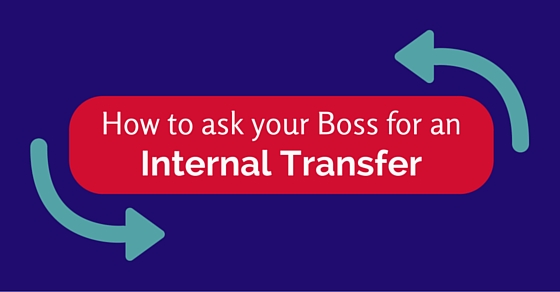
Bite-Sized tips to remember when requesting for an Internal Transfer
An internal transfer on the workplace.Best convincing ways to ask an internal transfer with the boss.

Have you been working under your boss for the past many years and feel like you need a change? Do you believe that there is a better job scope for you in a different department? Is there a different role in your firm that will allow you to evolve and grow? If answered yes to any of the queries above, then it’s time to request for an internal transfer.
What is an internal transfer?
An internal transfer may be a viable option when you want to continue working for the same company but in another department. There are other reasons you may opt for an internal transfer. They are-
- When you aren’t thrilled with your job but like your company.
- An internal transfer can be an excellent way to start a new career path when you want a change in your job function without having to seek employment with a new company.
- You can request for a transfer if you’re seeking to switch departments or want to work at a different job in the same company.
Sometimes, requesting for a transfer does not necessarily imply that you are unhappy with your current job position. Instead, a lateral move let you seek out promotions and diversify your portfolio. If you desperately want a change but don’t know where to begin, fret not! Here are five useful tips to follow when seeking for an internal transfer.
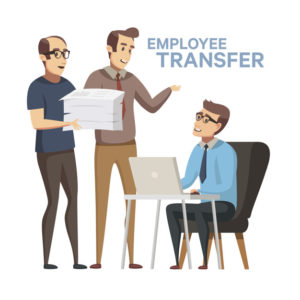
Five useful tips to follow when seeking for an internal transfer
- Do your homework
The first thing you should undoubtedly do before talking to your employer is to go through the company’s transfer policy. A lot of firms require employees to be in a position for a minimum number of years prior to requesting for a lateral transfer. So the last thing you should do is to request for a transfer before you meet this requirement, as that could easily backfire. You will end up with no chance of moving to a different team and stuck with an employer who knows you want to leave at some point.
Also, ensure to clarify the internal application process with your HR representative before having this delicate conversation with your employer. There is an immense difference between going to your boss with a well-thought-out plan and an unreasonable demand!
- Upgrade your resume
Once you have identified the positions available for internal transfer in your firm, it’s time to update your resume. Read through the job description in the available role thoroughly, identifying the important skills that the new department is expecting from the candidates. Then, list down your skills and expertise that match the new position. If you haven’t upgraded your resume in a long time, it would be a great idea to check and ensure your resume highlights your achievements. It increases your chances of landing your dream job.
Once you have updated your resume, make sure to identify the gaps between your skill set and the requirements for the new job. Come up with a strategic plan to achieve those skills in the next few months if possible. It let you close the gaps as much as possible before applying for the job role. Remember to highlight your plan to achieve the necessary competencies during your job interview. By doing this, you are showing your future boss not only that you care about your professional growth, but also that you are proactive.
- Brush up on your networking skills
When you want to seek out for an internal transfer, your networking skills should be sharp. You’ll never be able to understand the open position from the job description alone fully. So, talking to someone senior in the new department will help tremendously to understand the work culture and work expectations better. Make it a point to mingle with co-employers from different departments rather than just staying within your clique. This way, you can discover more about job vacancies and market your skills to potential employers informally before even heading for the interview!
- Make it clear that it’s not personal
The fact that you are requesting for an internal transfer doesn’t mean that you’re unhappy with your current employer, so make that clear! Explain to your manager why you are looking for this turn in your career. It will help to explain how you will add value to the new team with your technical experience. Ensure that you also articulate your gratitude for the expertise you have attained from your current team.
Even if you are requesting for an internal transfer because you are unhappy with the current boss, don’t apply to several openings within the same week. That just confirms that you’re despairing to jump ship. Instead, space out your applications and continue keeping your head down until you the transfer gets granted.
- Offer to train a replacement before leaving the role
When you request for an internal transfer, you are actually leaving your manager in a stressful point of finding a replacement for you in a short period. Now out of stress, they might, in turn, take it out on you. To keep a good relationship with your manager, even after you request for a lateral transfer, ensure to offer to make their life easier by training a replacement before leaving. Even if this lets you work extra hours to keep up with your pending assignments and the responsibility of training a replacement, it’s worth it as your employer would really admire your courtesy. There’s nothing awkward with requesting for a job transfer, just ensure to be aware of others’ feelings in the process.
Overall, requesting an internal transfer needs a level of tact, courtesy, and understanding of the process. Before you are ready to jump ship and dive into a new department, ensure, you follow these tips and prepare yourself.

How Businesses Should Handle the Coronavirus Outbreak

How Businesses Should Handle the Coronavirus pneumonia outbreak.Challenges for business in handling coronavirus epidemic or pandemic.

Corona – the deadly disease has arrived in many offices and employers around the world. The number is still increasing after every passing day. Around 93,526 coronavirus infection cases have been reported. It is far outpacing the SARS epidemic in the early 2000s. About 81 countries and territories around the world got affected, and 51,019 people only got recovered till now.
The daily reported cases outside of china have gone up considerably. Italy, South Korea and Iran are emerging as new hotbeds.
With coronavirus continuing to spread across the world, we have put together a handy guide. It is on the best practices companies, and human resources departments should follow to help their employees stay healthy and infection-free.
How Businesses Should Handle the Coronavirus Outbreak to ensure employees stay healthy and infection-free

- Effective Communication is Key
HR departments should pull together every information about the coronavirus to create a ready-to-refer instructional guide for employees. It not only educates them about the infection but also enlists the ideal ways to avoid it.
The communication strategy must be multi-pronged. You should use all channels of communication available to make the employees aware. You can use bulletin boards, stick posters on the wall, infographics, emails, videos, and any mode of media that could help to communicate the message to all employees effectively
The gathered information should only be from credible and verified sources. You can refer useful online pages, the CDC website, and reputable news outlets that attribute their knowledge to either statement made by governmental agencies, or health professionals engaged in the virus researching.
Execute Flexible Working Arrangement Plans or BCP Protocols. It is essential for the countries that share a border with China or have multiple reported cases of coronavirus infection. Allowing employees to work from home is a great way to prevent contamination, given that human-to-human transmission is possible.
By implementing flexible working arrangements, you can eliminate the possibility of transmission at the office and also during the commute. It is the best solution to help people in densely populated cities or packed urban areas to stay away from the disease. Employees can use chat platforms, project management dashboards and other platforms that are online or on the cloud.
It might not be possible for work that is location-dependent, though. Still, the CDC and WHO websites have laid out ways to avoid viral infections. They are implementing non-invasive approaches like face masks, alcohol-based hand sanitisers, and maintaining good personal hygiene.
- Reconsider employees Leave Policies
The last thing a company wants is an infected employee to turn up to work as they have no enough paid time off left. That not only hurts the sick worker who has to stress himself out to get to work, but also their colleague, as well as everyone and everything they encounter and touch on the way.
When a company is result-driven, no matter whether the employee work from home or in the office. You just need to ensure the work is getting delivered on time. As we have plenty of developments in today’s technology, there is a suite of solutions for companies to conduct meetings, discussions, and day-to-day work can go as usual.
For employees that are being sick, or start feeling ill during the day, especially those who are travelling, calling and notifying health authorities should be a priority. Fear mongering and forcing the sick employee into isolation, against their will, must be avoided at any costs until advised by the medical authority.
- Using technology to avoid human contact might not be a bad thing.
Platforms that let teams collaborate and communicate efficiently can be used during work-from-home days. Meetings can get done over Google Hangouts, Skype, or Zoom, while real-time collaborations can do using free platforms like Collabedit.
Other HR Initiatives, apart from providing free masks, and hand wash sanitisers, the cleaning schedule of the workspace can be increased.
- Senior management should make sure they mask up wherever appropriate to.
Temperature taking could be incorporated so that everyone in the workspace would have peace of mind and not be paranoid that their colleagues may get infected. Such information should be openly available so that workers have complete trust in the information provided.
Lastly, lunch could be catered to minimize employees’ exposure to crowded areas like the food centre.
The Corona crisis has now reached a new critical phase, and we need to take proper measures to take adequate care of ourselves and our family. Follow the above handy guide on best practices companies and human resources departments should deploy, and you’re your employees avoid exposure to the new virus strain.


Here are the eight questions employer should ask about coronavirus

What employer should ask about coronavirus. Fundamental question an employer should ask about coronavirus to ensure a safer workplace and the sanctuary of the employees.

The coronavirus outbreak originated in Wuhan, China. It has spread to at least 65 countries and sickened more than 89,000 people, with more than 3,000 deaths, as of March 2. Governments have closed their borders and imposed quarantines, and companies have banned travel. The human and economic impact on businesses has been stark.
This epidemic is the right moment for companies to review the strategies, policies and procedures carefully. They have to put them in place to protect employees, customers and operations for now and future epidemics. Here are eight questions that every employers should ask about coronavirus and respond to, the spread of the virus.

Eight questions that every employer should ask about coronavirus

- How can we protect our employees from the exposure?
The coronavirus that causes COVID-19 has thought to spread mainly through respiratory droplets produced from coughing and sneezing. It seems to spread quickly. It may also be possible to get infected by touching a contaminated surface or object and then touching one’s mouth or nose. The Centers for Disease Control and Prevention advises that employees should:
- Stay at home if they have respiratory symptoms (coughing, sneezing, shortness of breath) or a temperature above 100.4 degrees.
- Leave work if they develop any of these symptoms while at the workplace.
- You should shield coughs and sneezes only with a tissue, elbow or shoulder.
- Wash both your hands often with soap and water for a minimum of 20 seconds or use an alcohol-based hand sanitizer.
Since hand-washing is one of the most powerful defences, employers need to ensure that employees have ready access to washing facilities. And those should be kept well stocked with soap and paper towels. Alcohol-based hand sanitizers and sanitizing wipes should get distributed throughout the workplace. And all frequently touched surfaces, including work stations, countertops and doorknobs should be routinely cleaned.
- When should we exclude employees or visitors from the workplace?
As discussed above, employees should stay home or go home if they have symptoms of coronavirus infection. Managers should not hesitate to send workers who present with COVID-19 symptoms home. Besides, employees or visitors who are symptomatic or at high risk for COVID-19 should be kept separate from the regular staff. They must leave the workplace and obtain medical evaluation while minimizing their public exposure.
Public health organizations suggested that companies bar employees or visitors from coming to the workplace. It is essential for 14 days after a “medium” or “high-risk” exposure to the virus. It helps to avoid staying in close contact with someone who is known to be infected or having travelled from a high-risk region.
- Should we revise our benefits policies?
The number of employees unable to work is increasing. The reason is either because they are sick or because they must care for others. It means that it is the time companies should review their paid time off and sick leave policies. It will give employees confidence that they will not be penalized and can afford to take sick leave. It is an essential tool in encouraging self-reporting and reducing potential exposure.
While few firms outside of Asia have closed their worksites because of the epidemic. About half the Chinese companies had shut down worksites at least temporarily. Such closures will become more common outside of Asia if the epidemic continues on its current course.
- Have we maximised employees’ ability to work remotely?
Many jobs require employees to be physically present. But work including meetings can be done remotely should be encouraged if coming to work or travelling there risks exposure to the virus. For instance, videoconferencing is an excellent alternative to risky face-to-face meetings. Nearly 60% of the employers had increased employees’ flexibility for remote work (46%) or at least plan to (13%).
- Do we own reliable systems for real-time public health communication?
Dangerous rumours and worker fears can spread as quickly as a virus. Companies must reach all workers with regular, internally coordinated, factual updates about infection. You should make them aware of how to control the disease and its symptoms. Be clear with the company policy regarding remote work and circumstances. Let them aware of which employees might be excluded from or allowed to return to the workspace. The emergency response team should vet these communications. And they should be carefully organised to avoid inconsistent policies get communicated by different managers or functions. If you don’t have a current, universal contact capability already, now is an excellent time to create one.
- Should we revive our policies on international and domestic business travel?
Sixty-five per cent of companies are now restricting travel to and from Asia. It is essential to limit employee business travel from areas where COVID-19 is most prevalent. It can prevent both illnesses and avoid loss of productivity due to quarantine or employee exclusion from the workplace after the trip. Companies must track the CDC Travel Health Notices and the State Department Travel Advisories. It can determine what business travel should be cancelled or postponed. The CDC currently recommends that travellers avoid all nonessential trip to China, South Korea, Italy and Iran.
- Should we cancel or postpone scheduled conferences or meeting?
We have already seen scattered reports of cancelled in-person conferences and meetings. And we expect more reports in the upcoming months: 47% of employers are about to cancel planned meeting or conferences to North American employees in selected countries. Local health departments will declare guidance about whether events should be cancelled in a particular area. All conference organizers must provide information on diminishing the chance of infection. And they should assure that proper hand-washing facilities or hand sanitizers are readily available.
- Are supervisors adequately trained?
Sixty-five per cent of companies surveyed that have employees in China are training supervisors about the implications of COVID-19. And 34% of those with employees in North America report they are actively training or planning to train their managers. Whatever form the training takes, managers should have ready access to relevant information. And must know who to contact within the firm to report exposures. Managers or other designated persons in the company should promptly notify local health authorities about any suspected exposure.


Golden tips to provide quality feedback to your employees
Feedback to your employees is motivational to the employees. Analytical Feedback to your employees can be productive in the long run for good teamwork.

Feedback is something that can either make or break the performance of an employee. Almost every employee wants employee feedback, an honest assessment of their behaviour to help them improve their work. If an employee listens and takes action on, clear and constructive feedback, their overall performance will improve. It will not only result in Successful employee retention and promotion but also result in overall employee job satisfaction.
Not providing feedback can be detrimental. It can lead the employees two times more likely to be disengaged as they feel like their manager is ignoring them. So, it is crucial to ensure you communicate properly to your employees. Also, use this opportunity to cater to the development of your people.
- You should ensure that this feedback offers impact and makes a difference in your employees.
- How can you be sure to provide adequate feedback such as this?
The following tips will aid in this, so you can get started on developing your employees, and their performance, today!

How to feedback to your employees that get results

Be positive: Concentrate on what the person is doing to improve himself when you give feedback.
Focus on his behaviour, not the person: When you discuss a performance issue with any of your employees, keep your emotions in check. Focus on his actions, not the person.
Be specific: Provide solid examples of the behaviour in question. Do not ask vague, “drive-by” criticism like, “You have been arguing with clients a lot” or “I have heard several complaints about your attitude.”
Be timely: Don’t wait until the annual performance appraisal of the employee to provide positive or negative feedback. The closer feedback tie to the behaviour in question, the more powerful it will be.
Make sure you are very clear on why you are delivering the feedback: Feedback often arises from judgment, and we never want to pass it off as feedback. So, it’s critical to pause a moment and think about where the feedback is coming from and how can you deliver it to the employees in a way that he will receive positively.
Don’t consider judgment as a means for feedback: Never use feedback as a shield to share an actual criticism or be judgmental of another person. Judgment isn’t neutral. It is just your opinion on the character of a person.
Provide your feedback from a neutral place: Feedback is a piece of information or your observation, which you are sharing with your employee. Once a person gets the feedback from a neutral space, he can decide whether he should change or not.
Make it a two-way conversation: Take your time to engage your employee or team and check for understanding. Focus on “partnership,” not “this is what you’re doing wrong” or “this is what you need to change.”
Follow up: If your feedback concerns a problem, look for opportunities to “catch them doing it right.” Reinforce positive behaviour.
Make sure you have these qualities before delivering feedback: You can receive a Feedback in the best way when you establish authority, credibility and trust in a relationship. Without these things, it makes it more difficult to receive feedback.
Effective employee feedback is not one-size-fits-all. But, you can do a lot of things to make it a pleasant experience for everyone. Even the smallest gestures from you can make the biggest difference and help someone on their path to becoming a great worker.
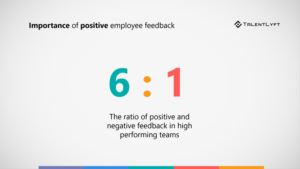
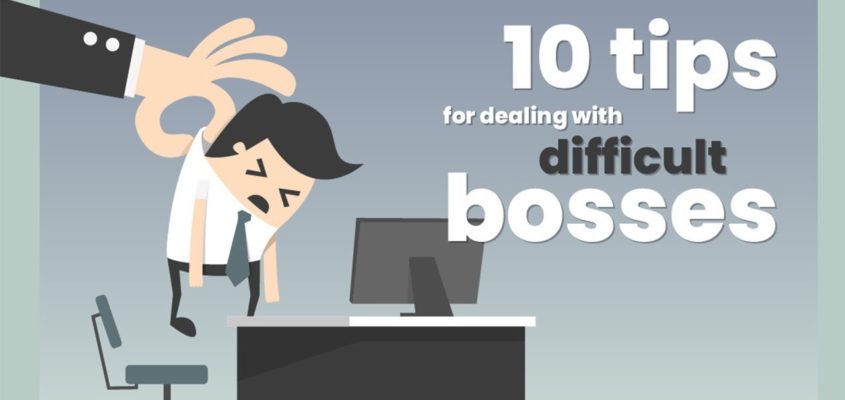
The actionable ways to work with difficult bosses
Work with difficult bosses is a tricky business.

Working for a boss who is competent, understanding, and supportive is excellent. But that isn’t the case always. Having the perfect boss is nearly impossible.
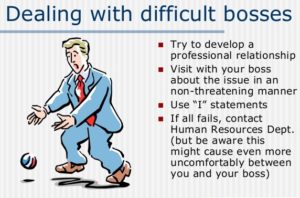
- Some bosses are just terrible,
- They are poor delegators and annoying micromanagers,
- Some of them are self-indulgently obsessed with the office gossip,
- They are only available on slack, where they consistently ignore your messages.
It’s critical to learn how to deal with the boss you have for your success. The best first step is to try to understand your boss and learn how to deal with their personality. There’s no doubt. Sometimes handling our bosses can be extremely difficult. In this blog, let us discuss a few common toxic bosses and the best ways to work with difficult bosses.
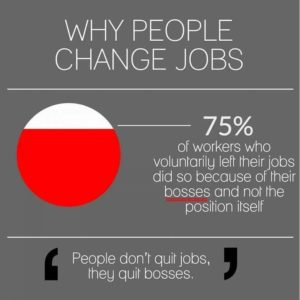
Common toxic bosses and the best ways to work with difficult bosses


- The Micromanager
The first and foremost kind of toxic boss is one who micromanages. They want to have input on every situation at every time. It’s not a personal attack on you or your work as the micromanager does this to everyone. They strive for perfection that can never get achieved.
How to Work With the Micromanager
There are several ways to deal with a micromanager. One way is to sit down with them and ask exactly what they want. This way, you can ensure you are clear about what they want, and you can both be on the same page. Fear of losing control is the reason why micromanagers exist. So, you should make them feel less fearful of entrusting tasks to you. It’s hard to get a micromanager to allow full freedom. Still, by getting them clearly, you should identify what they expect from you. When your boss sees you deliver the exact result, the working relationship will get better with time.
- The Dictator
Do you have a boss who tells you what all tasks to do, when to do them, and how to do them without allowing your input? This kind of bosses lives and breathes through his ego. They want power and want to be in charge. They also point fingers on you and want to intimidate you.
How to work with the Dictator
In this scenario, you must deal with your boss carefully. The goal is to avoid getting emotional or flustered. You have to be well calculated when dealing with a dictator boss. Let them have all the recognition. Since the ego of your boss leaves no room for yours, you have to get comfortable taking a back seat. Give them credit and trust that you did an excellent job. But be sure to keep a record of what you contribute, as this will be helpful in negotiations, and don’t release your value.
- The Inadequate One
It is the boss that made it through the ranks, and you don’t know, nor do they, how they got there. They are in over their head, and you have more knowledge and skills than they do, but they are at the top.
How to work with the Inadequate One
Don’t get frustrated. Just stop trying to highlight their incompetency. You know you have more knowledge than they do. You must let go of your pride and help elevate them because this will ultimately elevate you. Your boss will be so happy if you proceed to give them a helping hand, as this will make you both shine. Don’t try to hurt them; instead, help them out.
Though toxic bosses may be challenging, they are not impossible to work with. You can stop thinking that you can’t deal with them — because you can. You just have to know how to navigate through the situations, and these three tactics should help.


How to stop work life taking over your life?
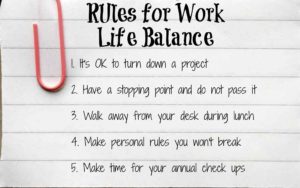
Work life taking over your life is a serious concern. Work life taking over your life has to get addressed with proper planning and accomplishment with honesty and devotedness.

“Don’t get so busy making a living that you forget to make a life.”
— Dolly Parton
We are living in an era were leaning in and working whatever hours it takes to get ahead in the profession. But in this race for career advancement, it can be increasingly easy to forget to take time for yourself. Most employees today find themselves with longer work hours and larger workloads. When you have more responsibilities, it’s hard not to let your career take precedence over everything in your life, which isn’t healthy.
Doing anything but work can seem like laziness or self-indulgence—especially when it looks like everyone else is still furiously working while you have taken off for the day. However, burnout is real. If you are not functioning at full capacity as you are mentally and physically exhausted, your work life and personal life will suffer.
The key is to obtain a good balance between your hard work and your outside life. Here are a few ways to ensure you have a healthy work and home life balance.
“Don’t confuse having a career with having a life.”
— Hillary Rodham Clinton

How to balance work life taking over your life?
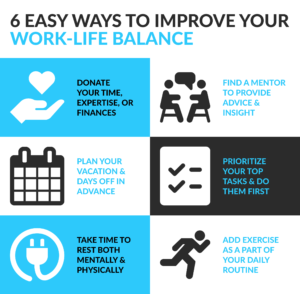
- Keep one-day meeting-free.
There are a lot of companies who establish one day a week as “meeting-free,”. In this day, no one is allowed to schedule any mandatory group gathering. If your firm doesn’t do this, suggest it to your employer. Setting aside one workday that’s just for you to work will do wonders for your productivity. You will get to finish your work during the day and take home less work and stress at night.
- Work from home if possible.
If you have an option of telecommuting at your job, take advantage of it. If it is not there yet, have a conversation with your boss. Even one day or half-day a week can help keep you grounded and give you a little bit of space extra that keeps you centred.
- Protect your time away from the office.
If you have to take work home, ensure you set strict time limits for yourself so that it doesn’t eat up all of your out-of-office time. Finish all the critical works. Respond only to the most important emails, then leave the rest for when you are back at your desk. And unless it is truly an emergency, try to make it a policy not to respond to work emails over the weekends. Your weekend time is your own.
- Fit in exercise.
Build your workday with simple exercises such as a half-hour walk during the lunch break. If that is not possible, adjust your weekly routine, and add one or two hours for exercise. Exercising will keep you fit, sharp, young, and full of endorphins. You can afford to find the time, so go ahead and ensure you do, your body and brain will thank you. Taking care of your body will take care of so much else.
- Make family your priority.
The people who love you and you love in your life aren’t replaceable, and your job should know that. So, show up if any emergencies come. Make some time to be there for the people you love as a rule, not as an exception.
- Take vacation.
Vacation and personal time exist for some reason. Take every day you are allowed. You are supposed to use these days, and you will be glad you did. Your work and attitude will undoubtedly improve after taking a short break.
- Schedule some blank time.
Rather than scheduling yourself to the gills, from your alarm turning off in the morning until bedtime, ensure you block off time in your schedule when you don’t have anything to do. Let your brain really and truly relax, and it will stay creative and sharp.
You may not be able to give yourself a full half-hour or one hour every day, but you can try it. Even just twenty minutes to sit calmly and meditate or take a brisk walk can make a difference in your attitude and your health.
“If you can’t do anything about it then let it go. Don’t be a prisoner to things you can’t change.”
— Tony Gaskinsl


How to respond when your promotion got turned down?

There’s nothing quite like the disappointment of not getting a promotion when you had your heart set on the move.
Maybe you were passed over in favour of a colleague. Or, perhaps your request for promotion was denied simply. Whatever be the reason, eventually, it is time to dust yourself off and move on.
There are numerous things you can do, starting right now, to help the page turn. You might even find that one day you look back on this entire thing from a completely different perspective. It will be the beginning of the next phase of your career. Get a few tips that help you move on.

How to move ahead when promotion got turned down?

- Don’t let yourself overwhelmed by this for too long.
Just like so many things happen in life, the way you think about this rejection is important. The sooner you get to the point where you regard it as disappointing rather than devastating, the better off you will be.
Eventually, this experience can help you walk toward other opportunities and other promotions. But, if you adhere to your negative emotions, it will send you in the complete opposite direction.
- Don’t do anything rash.
In the immediate aftermath of this setback, you should allow yourself to feel whatever emotions surface for you. It’s necessary to wade through these challenging feelings to move past them. But, you don’t need to take action based on these emotions. Acting out or reacting, without really considering the consequences, is not a good idea.
- Take some time.
When you are feeling stronger, you can work on turning these lemons into lemonade. But first, you should take care of yourself and get back on your feet. You don’t need to start a yoga class or take up knitting — self-care can be simple and easy. Just do what feels right for you.
You should also spend some moments thinking about other things. Schedule some fun activities with family and friends. Or, maybe a weekend gets away. You will be more equipped to turn this thing around once you have taken some time.
- Try to understand what happened.
If you are going to flip this negative into a positive, you need to grasp why you didn’t get the appraisal you thought you deserved. You might think you know the reason behind it, but it is probably a good idea to check those assumptions.
When you are ready, have a sit-down with someone who can answer your queries. It’s absolutely all right to express that you are depressed. But, consider it as a context of learning from the experience and continue to grow and develop professionally.
Listen carefully to whatever feedback you are given without becoming defensive. Remind yourself that you need to seek to understand first. You can fret about what to do with the information later.
- Come up with a powerful action plan.
Once you get to know what went wrong, you can start planning how to move ahead and improve in the future. Have a conversation with HR or your boss about your goals and how you can work to accomplish them. Then, come up with your action plan and give yourself a timeline that’s reasonable for achieving them. You might even request a follow-up meeting later so that you can check in about these goals.
- Keep your network active.
There might be other reasons why you didn’t get this promotion. Some of them will be within your control and without your control. Despite what happens next, it can’t hurt your options to stay active within your professional network. So, dust off the cobwebs around your connections that can help you. You never know what opportunities could land in your way.
- Remember that moving forward is always an option.
Sometimes, after exhausting other alternatives, it becomes evident that there isn’t a path to the job you want with this firm, or maybe even within the industry. In this scenario, it could be time to consider moving on.
However, you should stay on good terms with your colleagues from this job. So, never burn any bridges on your way out the door. And, remember that you are not just leaving a job behind. You are walking toward one, too. You will end up grateful for this experience in the long run.

How top leaders stand out from the competitors?

How top leaders stand out from the competitors. Competitors are the one who never bothers about you at all. Competitors keep doing better every time motivating us to be better.

Every business venture should maintain a position in the market to stay ahead of the competitors. As a business leader, you need to ensure that your core processes and strategy set you apart from the rest. You need to give your customers good reasons to come to you rather than your opponents.
Competition exists in every market. Smarter companies nullify the effect of competitors to stay ahead in the business.
So, how do they do that?
Here are five powerful ways to beat your competitors.

Powerful ways to beat your business competitors


- Identify and resolve the pain points of your customers.
Ask open-ended questions. It will help you find what exactly your customers want while using your products or services.
The key here is to give solutions to the prospects and supply them what they need. Never sell them what you want to sell. You only need to fulfil their need, not “sell” anything. Your product will start to sell more the moment you fill the void that your competitors are lacking.
- Build your own niche to have more scope for your business.
An already crowded market has less scope for expansion. So offer something unique to your customers to build your own niche and reduce the existing competition.
Storytelling is a great way. You can craft stories about your products. With the help of these stories, you can become a part of your prospect’s lifestyle. You can use burst offers free stock photography. It helps you create and promoting stories about your brand across social media.
Specialisation always leads to a successful business. A niche market is safe and reliable, and the prospects are easy to target. Moreover, the customer retention rate is good. Start with targeting relevant platforms where your target clients might be present. You can adopt a niche marketing strategy for them.
- Get the pricing correct.
Perfect pricing strategy revolves around marketing psychology. It is necessary to know the competition before setting a pricing strategy. You should identify who is providing the best value for money. The price you set must be standard and should have a competitive advantage.
A great pricing method does not always mean lowering the prices of existing products to win more customers. Every market has classified into three sections – the lower, middle and upper class. The first step is to choose the class you are targeting. Once you decide it, you can set a price that your audiences will love to pay.
- Make innovation, your best friend.
Change is the only thing that is permanent. So, innovate your products and services, and don’t hesitate to take the risk. For example, you could add enhanced skills to your existing business methods using virtual reality applications like Samsung Gear VR.
Giants like BlackBerry and Nokia were wiped out from the smartphone market as they lack innovation. Always remember that your competitors are innovating regularly, and new entrants are disrupting the marketplace. Your business should often innovate and in a manner that the competition finds it hard to follow.
- Improve your customer service.
People love businesses that provide outstanding customer service. Delight your customers with excellent service. Then, you will make loyal customers who will refer your business to their family and friends.
Hire staffs who have a good knowledge of your products or services. Ensure that they remain patient and give satisfying answers to every customer query.
Your staff should greet consumers with a pleasing smile and must show gratitude. It is vital to boost the team spirit of your staff and hire team players. Never forget to reward the team players, as employees need constant motivation to outperform others.
Your customer care team must always remain courteous and respectful. They must be responsive to customer queries. They should adopt a problem-solving approach and always ask for customer feedback. Customer-centric firms are powered by dependable staff who raise the level of customer satisfaction.
It is essential to define your brand and set a USP. Stay ahead of your race in terms of price, quality and customer service. Moreover, you must have open discussions with your customers so that you can retain them for a lifetime.


Steps to follow when your boss does not love you

Steps to follow when your boss does not love you. Boss does not love you is not a good sign on the workplace. Strategies to have when the boss does not love you in the office.
Do you ever feel your boss doesn’t love you? Well, we all love to live in a world where everyone likes us and our workspace gets filled with a flurry of friendly waves and gracious smiles. But that’s not how life works. Sometimes, it starts out with a hint. Maybe it’s the way your boss looks at you. Or perhaps it’s the way you always get the less-desirable tasks.
If you pay attention, you will find plenty of signs your boss doesn’t like you. For one reason or another, you have started to doubt that your employer doesn’t like you. In fact, they may just plain hate you. Yikes! Now what?
Working with someone who doesn’t like you is not fun. However, it’s not either the end of the world. Your first instinct might be to jump ship and look for a fresh start or transfer to a different department. Yet you don’t need to go that far. There are lots of other things you can do, and a few you shouldn’t do to win the boss over. Here is what you need to do when your boss doesn’t like you.

What do you need to do when your boss does not love you?

- Stay involved
From big projects to team meetings, you should ensure that your boss sees you right in the thick of things. For dealing with your employer, you should be a strong contributing member to your department. Maybe your boss doesn’t like you, but they will respect the way you manage your tasks and how much you add to the business. Do a little subtle self-promotion if you need to. It’s not enough to just be there and getting work done. You need to get immersed in your team and your company and show that you are a key cog in the wheel.
- Don’t try to go unnoticed
If you are thinking “My boss hates me,” your first instinct may be to put your head down, do your work silently without ruffling any feathers. Everyone likes a person who calmly gets their job done, right? No, it’s wrong. The best that strategy can do for you is to push you from being disliked to unnoticed. And neither one is going to aid you to advance your career.
On the contrary, it will make your situation worse. If your employer doesn’t like you, it may be that they don’t see you as an asset to the team. If you go silent and become less involved, your boss may decide you are not worth keeping around at all. Unnoticed is usually unneeded.
- Say “Hi!” to your boss
It is a hard one, especially if there are signs your boss doesn’t like you. Yet, here’s a simple truth: Most people like those who show an interest in them. Don’t just say “Hi!” and walk away from there. Engage them in casual conversation by keeping the focus on your employer. Ask queries and try to get them talking about their interests. Learning about their likes and dislikes makes the next conversation even easier. You can get to know them better by spending just a few seconds each day. Let your boss know that you are a fun person to talk to and perhaps that ice will start to melt away.
- Never avoid your boss
Never change your way when you see your boss near the coffee machine at the same time you are there. Or never hesitate sitting next to him at team meetings. It may seem like subtle strokes of genius to you. And they will eventually stand out to your boss. Then what? They will wonder why you are avoiding them.
- Are you not getting your work done?
- Is there anything you are trying to hide?
If you thought your employer didn’t like you before, you really wouldn’t have to wonder if they notice that you are avoiding them. Don’t do it.
- Compliment your boss
A genuine compliment can take you a long way when it is done right. You don’t need to be obvious and come across as a kiss-up. But there is nothing wrong with a well-placed compliment, especially when you feel your boss doesn’t like you. The trick is to keep it professional. Personal compliments about physical appearance or clothing are dangerous ground. Make it simple work-related topics like “You did a nice job on the presentation at the meeting.” Follow it up with a small detail to show him that you really observed and you could be in for smoother sailing. Don’t makeup compliments. Instead, look for those things you can genuinely show appreciation.
- Don’t bad mouth your employer
Never badmouth your boss or tell others you think he doesn’t like you. It may be a simple office chatter, but it can trouble you. Even when you feel you have found a sympathetic ear, you don’t know who that person will tell and so on. Once you are in the gossip chain, there is a chance that it will get back to your employer, and it will be connected to you. Do you want to get called into that office cabin for a closed-door session that begins with “So, I hear you have been saying …”? Talking unnecessary things about your boss is a sign of disrespect that will quickly land you in hot water.
Not everyone likes everyone else. It means that your boss may or may not like you. It’s a harsh reality. If they still appreciate you and the work you do, you should just ignore it. But if it is making your life and your job miserable, follow the above steps to try and bridge that gap. It may be a misunderstanding that you can work through with a positive attitude and effort.

End of content
No more pages to load






